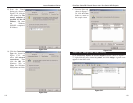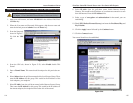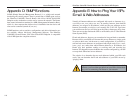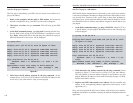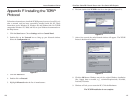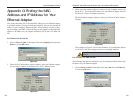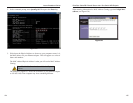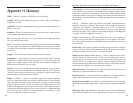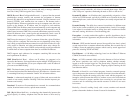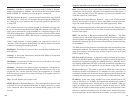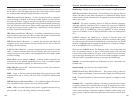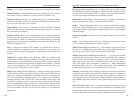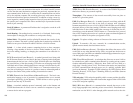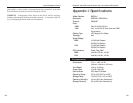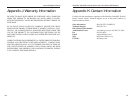
EtherFast
®
Cable/DSL Firewall Router with 4-Port Switch/VPN Endpoint
TFTP (Trivial File Transfer Protocol) - A version of the TCP/IP FTP protocol
that has no directory or password capability.
Throughput - The amount of data moved successfully from one place to
another in a given time period.
UDP (User Datagram Protocol) - A method (protocol) used along with the IP
(Internet Protocol) to send data in the form of message units (datagram)
between network devices over a LAN or WAN. While IP takes care of handling
the actual delivery of the data (routing), UDP takes care of keeping track of the
individual units of data (called packets) that a message is divided into for effi-
cient delivery over the network. UDP is known as a "connection-less" protocol
due to NOT requiring the receiver of a packet to return an acknowledgment of
receipt to the sender of the packet (as opposed to TCP).
Upgrade - To replace existing software or firmware with a newer version.
Upload - To transmit a file over a network. In a communications session,
upload means transmit, download means receive.
URL (Uniform Resource Locator) - The address that defines the route to a file
on the Web or any other Internet facility. URLs are typed into the browser to
access Web pages, and URLs are embedded within the pages themselves to pro-
vide the hypertext links to other pages.
VPN (Virtual Private Network) - A technique that allows two or more LANs to
be extended over public communication channels by creating private commu-
nication subchannels (tunnels). Effectively, these LANs can use a WAN as a
single large "virtually private" LAN. This removes the need to use leased lines
for WAN communications through secure use of a publicly available WAN
(such as the Internet). Examples of VPN technology are: PPTP (Point to Point
Tunneling Protocol), L2TP (Layer 2 Tunneling Protocol), and IPSec (Internet
Protocol Security).
VPN end point - VPN end point capability within a router provides the ability
to initiate a VPN tunnel to some other location that supports either a VPN client
or has VPN end point capability.
WAN (Wide Area Network)- A communications network that covers a rela-
tively large geographic area, consisting of two or more LANs. Broadband com-
munication over the WAN is often through public networks such as the tele-
137
Instant Broadband
®
Series
et than just its source and destination information. It is called "stateful" because
verifies that the stated destination computer has previously requested the cur-
rent communication. In this way, it verifies that all communications are initiat-
ed by the recipient computer and are taking place only with sources that are
known and trusted from previous interactions. In addition to being a more rig-
orous inspection, stateful packet inspection closes off ports until connection to
the specific port is requested. This allows an added layer of protection from the
threat of port scanning.
Static IP Address - A permanent IP address that is assigned to a node in an IP
or a TCP/IP network.
Static Routing - Forwarding data in a network via a fixed path. Static routing
cannot adjust to changing line conditions as can dynamic routing.
Subnet Mask - The method used for splitting IP networks into a series of sub-
groups, or subnets. The mask is a binary pattern that is matched up with the IP
address to turn part of the host ID address field into a field for subnets.
Switch - 1. A data switch connects computing devices to host computers,
allowing a large number of devices to share a limited number of ports. 2. A
device for making, breaking, or changing the connections in an electrical cir-
cuit.
TCP (Transmission Control Protocol) - A method (protocol) used along with
the IP (Internet Protocol) to send data in the form of message units (datagram)
between network devices over a LAN or WAN. While IP takes care of handling
the actual delivery of the data (routing), TCP takes care of keeping track of the
individual units of data (called packets) that a message is divided into for effi-
cient delivery over the network. TCP is known as a "connection oriented" pro-
tocol due to requiring the receiver of a packet to return an acknowledgment of
receipt to the sender of the packet resulting in transmission control.
TCP/IP (Transmission Control Protocol/Internet Protocol) - The basic com-
munication language or set of protocols for communications over a network
(developed specifically for the Internet). TCP/IP defines a suite or group of
protocols and not only TCP and IP.
Telnet - A terminal emulation protocol commonly used on the Internet and
TCP/IP-based networks. It allows a user at a terminal or computer to log onto
a remote device and run a program.
136



